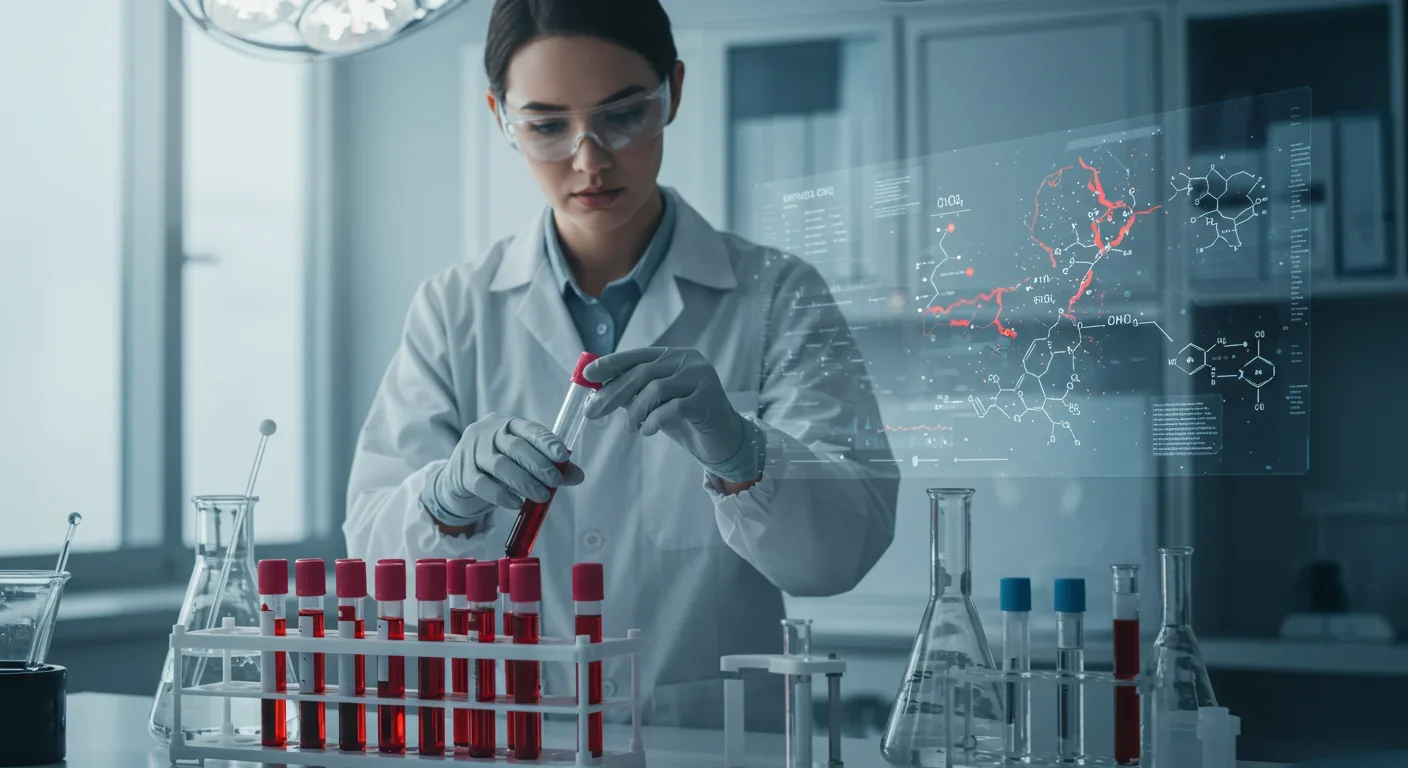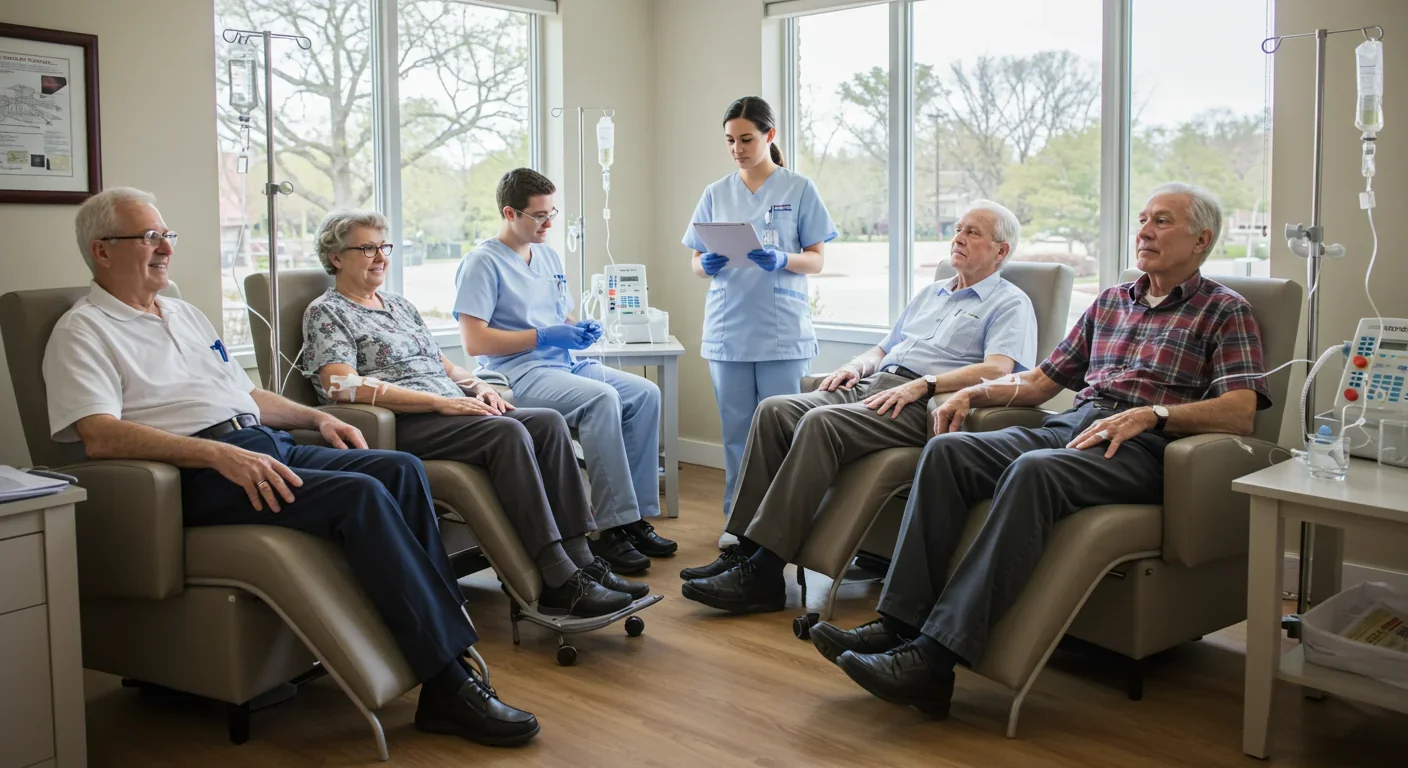Ultrafine Particles Breach Brain Barriers: Hidden Risk

TL;DR: Young blood transfusions show promise for reversing age-related cognitive decline in animal studies, but human trials remain inconclusive and the FDA warns against unproven commercial treatments.

Imagine waking up at seventy with the memory sharpness you had at thirty. Sounds like science fiction, right? Yet researchers are exploring whether young blood might actually turn back the cognitive clock, a concept that's moved from mice labs to human trials. The technique, called heterochronic parabiosis, began when scientists surgically joined the circulatory systems of young and old animals and watched something remarkable happen: the old animals' brains started looking younger.
By 2030, millions of people worldwide will face age-related cognitive decline. Current treatments only slow symptoms, they don't reverse damage. But what if the solution has been flowing through our veins all along? This isn't about vampires or fringe medicine anymore. It's about understanding how circulating factors in young blood can rejuvenate aged tissue, particularly the brain, and whether we can harness that power safely and ethically.
Heterochronic parabiosis literally means "living beside at different ages." Scientists surgically connect the circulatory systems of a young mouse and an old mouse, so they share blood. Within weeks, the old mouse shows restored stem cell function, improved muscle strength, better liver performance, and crucially, enhanced memory and learning. The young mouse, meanwhile, starts showing signs of aging. Something in the blood environment is controlling the aging clock.
Experiments like this started back in the 1950s at Cornell University under Clive McCay, but for decades they were dismissed as anecdotal curiosities. Then in the 2000s, researchers at Stanford and UC Berkeley revisited the idea with modern molecular tools. They discovered that exposure to young blood reversed age-related impairments in brain, liver, heart, and skeletal muscle. Even more striking, a 2020 Berkeley study showed that you don't need whole young blood at all. Simply replacing old plasma with saline and young albumin was enough to rejuvenate brain, liver, and muscle tissue.
That finding flipped the field on its head. It suggested the problem wasn't a lack of youthful factors, it was an excess of aging factors. Diluting the old blood environment, clearing out accumulated inflammatory proteins and metabolic debris, allowed the body's own repair systems to kick back in.
Your brain doesn't age in isolation. It's bathed in blood that carries oxygen, nutrients, hormones, and signaling molecules. As you age, the composition of that blood shifts. Pro-inflammatory cytokines like IL-1B and TNF-alpha increase, while growth factors like GDF11 and TIMP2 decline. The result? Chronic low-grade inflammation, what scientists call "inflammaging," which damages neurons and impairs the blood-brain barrier.
Young monocytes, immune cells from young blood, clear myelin debris more effectively than old monocytes. Myelin is the insulating sheath around nerve fibers, and when it degrades with age, signal transmission slows down. That's one reason older brains process information more slowly. Introducing young monocytes into aged mice revitalized their ability to clear this debris and even reversed demyelination in the central nervous system.
Another key player is TIMP2, or tissue inhibitor of metalloproteinases-2. This protein, abundant in young blood, enhances synaptic plasticity and improves hippocampal function, the brain region crucial for memory formation. Researchers found that injecting TIMP2 alone into aged mice improved their performance on memory tests. It's not magic, it's molecular messaging. Young blood tells old cells: "You can still repair. You can still regenerate."
Growth factors also matter. GDF11, a protein that declines with age, was initially hailed as a rejuvenation factor after studies showed it improved muscle and brain function in old mice. Though some studies raised concerns about its effects on muscle mass, the overall evidence suggests that restoring youthful levels of multiple factors, not just one, creates the rejuvenating environment.
In 2014, researchers announced clinical trials based on young blood transfusion were scheduled to begin. Fast forward a decade, and several companies and research groups have tested variations of the idea. Alkahest, a biotech startup spun out of Stanford research, partnered with pharmaceutical giant Grifols to develop plasma-based therapies for Alzheimer's disease. Their early-stage trials in patients with mild to moderate Alzheimer's showed some encouraging signs, improved functional ability and cognitive scores, though the results were modest and not definitive.
Then there's Ambrosia, the controversial startup that since 2016 has sold "young blood transfusions" for $8,000 per session. Their "clinical trial" had no control group, no randomization, and no blinding, making it scientifically worthless. In 2019, the FDA issued a sharp warning, cautioning consumers against receiving young donor plasma infusions as "unproven treatments." The agency was clear: there's no evidence these infusions provide any benefit, and they carry real risks, including allergic reactions, infections, and transfusion-related injuries.
Despite the hype and ethical concerns, legitimate research continues. A 2023 study reported that the rheumatoid arthritis drug anakinra, which blocks the inflammatory cytokine IL-1B, returned elderly mice's bone-marrow stem cells to a more youthful state. This approach, rejuvenating the blood factory itself instead of transfusing young blood, could sidestep donor shortages and safety issues.

Other researchers are exploring therapeutic plasma exchange, or TPE. Instead of adding young blood, you filter out the old plasma and replace it with saline-albumin solution. Early trials in humans have shown improvements in biomarkers of inflammation and even cognitive function. The idea is simple: remove the bad stuff, let the body's endogenous repair mechanisms do their job.
The big question is whether these interventions can meaningfully improve human cognition. Mouse studies are promising. Young blood reversed age-related impairments in cognitive function and synaptic plasticity, improving memory, learning, and neuronal connectivity. Aged mice that received young blood performed as well as young mice on maze tests and object recognition tasks.
Translating that to humans is harder. Human brains are vastly more complex, and cognitive decline has multiple causes: vascular damage, protein aggregation (like amyloid and tau in Alzheimer's), mitochondrial dysfunction, and neuroinflammation. Young blood or plasma exchange might address some of these, particularly inflammation and vascular health, but it's unlikely to be a cure-all.
Still, the potential is real. If plasma exchange or targeted protein therapies can reduce neuroinflammation and restore synaptic plasticity, they could slow or partially reverse early-stage cognitive decline. Patients in the early stages of Alzheimer's or vascular dementia might maintain independence longer. Healthy older adults might preserve memory and processing speed. Rejuvenating the brain's environment could give neurons the support they need to function optimally.
Moreover, combining young blood factors with other interventions, exercise, cognitive training, dietary changes, could amplify the effects. Think of it as creating a comprehensive pro-youth environment for the aging brain.
Young blood transfusion isn't risk-free. Transfusions always carry risks of infection, immune reactions, and allergic responses. Repeatedly transfusing blood from young donors raises questions about donor safety and the ethics of creating a market for youth.
There's also the "vampiric" optics. The idea of wealthy older people buying blood from young donors evokes dystopian imagery and deepens societal divides. Critics rightly point out that over 100 companies have marketed young plasma infusions since 2016, despite the FDA never approving any such therapy. This commercial gold rush, driven by desperation and hype, has outpaced the science.
Then there are biological risks we don't fully understand. While short-term parabiosis studies in mice show benefits, we don't know the long-term consequences of altering blood composition in humans. Could it disrupt hormonal balance? Increase cancer risk? Trigger autoimmune responses? The FDA's 2019 warning emphasized these unknowns, urging caution until rigorous trials provide clear evidence.
Another concern is donor age. Studies suggest that blood from donors under 20 years old is associated with higher recipient mortality, possibly because very young blood has different immune profiles. Determining the optimal donor age range and the safest transfusion protocols will require extensive research.
Finally, there's the question of equity. If young blood therapies prove effective, will they be affordable and accessible, or reserved for the wealthy? History suggests medical breakthroughs often entrench inequality unless deliberately designed to be inclusive.
Understanding the mechanisms is crucial for developing safer, more targeted therapies. Researchers have identified several pathways through which young blood exerts its effects.
Clearing Inhibitory Factors: Old blood accumulates proteins that inhibit regeneration. For example, beta-2-microglobulin (B2M), a protein elevated in aged blood, impairs neurogenesis and cognitive function. Diluting or filtering out these inhibitors allows dormant stem cells and progenitor cells to reactivate.
Restoring Growth Signals: Young blood is rich in growth factors and signaling molecules that promote tissue repair. GDF11, TIMP2, and others enhance synaptic plasticity, neurogenesis, and vascular health. Restoring these signals provides aged cells with the cues they need to maintain and repair tissue.
Modulating Inflammation: Chronic inflammation is a hallmark of aging. Young blood has a balanced cytokine profile, lower levels of pro-inflammatory cytokines and higher levels of anti-inflammatory mediators. This shift reduces neuroinflammation and supports immune function.
Epigenetic Reprogramming: Emerging research suggests young blood factors can influence gene expression through epigenetic modifications. Epigenetic reprogramming resets the epigenetic clock and restores youthful function in aged cells without changing the DNA sequence itself. This could explain some of the broad, systemic effects observed in parabiosis.
Improving Blood-Brain Barrier Integrity: The blood-brain barrier weakens with age, allowing harmful substances into the brain. Young blood factors help restore barrier integrity, protecting neurons from inflammatory insults.
These mechanisms aren't mutually exclusive. They work together in a complex web of interactions. The challenge is identifying which factors are essential and developing therapies that deliver them safely and effectively.
To move from intriguing science to viable therapy, several milestones must be reached. First, we need large, well-designed randomized controlled trials. These trials must test not just whole blood or plasma, but also specific protein cocktails, to identify the minimum effective intervention. Researchers are investigating isolated blood components and epigenetic reprogramming strategies to deliver targeted rejuvenation without whole-blood transfusion.
Second, we need better biomarkers. Cognitive tests are valuable, but they're subjective and slow to show change. Molecular biomarkers, blood levels of inflammatory cytokines, neuroimaging markers of brain connectivity, could provide faster, more objective measures of treatment response.
Third, regulatory pathways must be clear. The FDA's 2019 warning was a necessary corrective, but it also highlighted the need for a framework that allows legitimate research while protecting consumers from exploitation. Plasma-based therapies should be treated as biologics, subject to rigorous pre-clinical and clinical testing.
Fourth, ethical guidelines must address donor safety, informed consent, and equitable access. Young donors should not be coerced or commodified. Trials should include diverse populations to ensure findings are broadly applicable.
Finally, we need long-term safety data. Even if early trials show cognitive benefits, we won't know the full risk profile until thousands of patients have been followed for years.

Research into young blood rejuvenation is a global effort, though the U.S. currently leads in terms of funding and publication volume. Stanford, UC Berkeley, and Harvard have been at the forefront, publishing landmark studies on parabiosis and plasma factors.
In Europe, Alkahest's partnership with Grifols, a Spanish pharmaceutical company, has brought European clinical expertise and regulatory frameworks into play. European regulators tend to be cautious, demanding robust evidence before approval, which could slow commercialization but improve safety standards.
Asia is also active. Chinese and Japanese research groups are exploring combinations of young blood factors with traditional medicine approaches. South Korean biotech firms are investing in plasma therapies, seeing them as a high-growth sector.
The private sector is a mixed bag. Some companies, like Alkahest, are conducting legitimate trials. Others, like Ambrosia, are selling unproven treatments. This disparity underscores the need for international standards and cooperation.
Cultural attitudes toward aging vary widely. In some East Asian cultures, aging is revered, and anti-aging interventions might face cultural resistance. In contrast, Western societies often embrace youth-oriented medical technologies. These cultural differences will shape how therapies are adopted and regulated globally.
If young blood therapies prove effective, how should society prepare? First, we'll need to manage expectations. This won't be a magic bullet. It might slow decline or modestly improve function, but it won't turn an eighty-year-old brain into a twenty-year-old brain.
Second, healthcare systems must plan for integration. If plasma exchange or protein therapies become standard care for age-related cognitive decline, that will require infrastructure, training for clinicians, facilities for plasma processing, systems for donor recruitment. Medicare and insurance companies will need to decide coverage policies.
Third, individuals can take steps now to support brain health. Exercise, particularly aerobic exercise, promotes neurogenesis and vascular health. A Mediterranean-style diet, rich in omega-3 fatty acids, antioxidants, and polyphenols, reduces inflammation. Cognitive training and social engagement maintain neural plasticity. Even if young blood therapies arrive, lifestyle will still matter.
Fourth, we should invest in education and public awareness. People need to understand what these therapies can and cannot do, and be wary of hype and predatory marketing. Health literacy is a shield against exploitation.
Finally, we must advocate for equitable access. Therapies that benefit only the wealthy worsen social divides and erode trust in science. Policymakers, researchers, and industry leaders should prioritize affordability and accessibility from the start.
If you're caring for a loved one with cognitive decline, the prospect of young blood therapies offers a glimmer of hope, but also caution. Legitimate clinical trials are ongoing, and organizations like Alkahest are recruiting participants for Alzheimer's studies. Ask your doctor whether your loved one might be eligible. Avoid paying out-of-pocket for unproven commercial treatments; the risks outweigh any speculative benefit.
If you're an investor, the field is high-risk, high-reward. Companies developing plasma-based biologics or targeted protein therapies could see significant returns if trials succeed. But be wary of startups offering miraculous claims without peer-reviewed evidence. Look for partnerships with established pharmaceutical firms, regulatory approvals, and transparent clinical data.
If you're a healthy adult concerned about aging, focus on the controllable factors: exercise, diet, sleep, stress management, and social connection. These are proven to preserve cognitive function. Keep an eye on emerging research, but don't invest hope or money in unproven therapies.
And if you're a young person, you're not a commodity. Donating blood is noble, but no one should pressure you into repeated donations for anti-aging purposes. Your health matters, too.
Young blood transfusion sits at the intersection of biology, ethics, and hope. The science is real: factors in young blood can rejuvenate aged tissues, including the brain, in animal models. Early human trials show hints of benefit, though nothing definitive yet. The mechanisms, clearing inhibitory factors, restoring growth signals, reducing inflammation, make biological sense.
But we're still in the early innings. The FDA was right to warn against unproven treatments. We need rigorous trials, long-term safety data, and ethical frameworks before young blood therapies become standard care. The potential to slow or reverse cognitive decline is tantalizing, but premature commercialization risks harming patients and discrediting the science.
What's clear is that aging isn't an immutable fate. It's a process influenced by systemic factors, many of which we can measure, manipulate, and maybe even reverse. Whether through young blood, plasma exchange, targeted proteins, or approaches we haven't yet imagined, the goal is the same: to give people more years of healthy, vibrant cognition.
The future might not look like parabiosis labs with mice stitched together. It might look like a monthly infusion of carefully formulated proteins, or a pill that blocks inflammatory cytokines, or gene therapy that resets your epigenetic clock. The path is uncertain, but the destination, a world where cognitive decline is treatable, reversible even, is within sight.
For now, we wait for the data. We support rigorous research. We protect vulnerable patients from exploitation. And we hold onto hope, tempered by the discipline of science, that one day, aging minds might remember what it's like to be young.

MOND proposes gravity changes at low accelerations, explaining galaxy rotation without dark matter. While it predicts thousands of galaxies correctly, it struggles with clusters and cosmology, keeping the dark matter debate alive.

Ultrafine pollution particles smaller than 100 nanometers can bypass the blood-brain barrier through the olfactory nerve and bloodstream, depositing in brain tissue where they trigger neuroinflammation linked to dementia and neurological disorders, yet remain completely unregulated by current air quality standards.

CAES stores excess renewable energy by compressing air in underground caverns, then releases it through turbines during peak demand. New advanced adiabatic systems achieve 70%+ efficiency, making this decades-old technology suddenly competitive for long-duration grid storage.

Our brains are hardwired to see patterns in randomness, causing the gambler's fallacy—the mistaken belief that past random events influence future probabilities. This cognitive bias costs people millions in casinos, investments, and daily decisions.

Forests operate as synchronized living systems with molecular clocks that coordinate metabolism from individual cells to entire ecosystems, creating rhythmic patterns that affect global carbon cycles and climate feedback loops.

Generation Z is the first cohort to come of age amid a polycrisis - interconnected global failures spanning climate, economy, democracy, and health. This cascading reality is fundamentally reshaping how young people think, plan their lives, and organize for change.

Zero-trust security eliminates implicit network trust by requiring continuous verification of every access request. Organizations are rapidly adopting this architecture to address cloud computing, remote work, and sophisticated threats that rendered perimeter defenses obsolete.